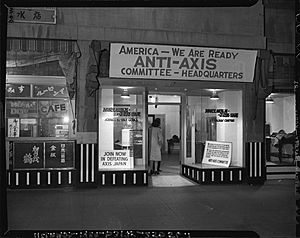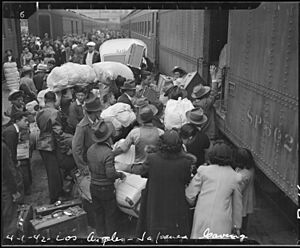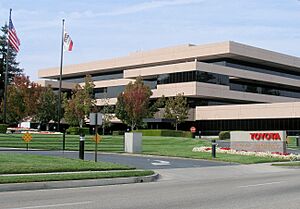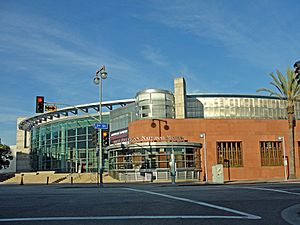History of the Japanese in Los Angeles facts for kids
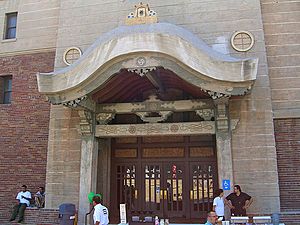
Los Angeles is home to many Japanese American people and Japanese citizens. Japanese people started coming to the United States in the late 1800s. They settled in places like Hawaii, Alaska, and California. Los Angeles became a major center for people of Japanese heritage over many generations. Areas like Little Tokyo and Boyle Heights are important to this community. In 2017, about 110,000 Japanese and Japanese American people lived in Los Angeles.
Contents
A Look Back: Japanese History in Los Angeles
After a law called the Chinese Exclusion Act was passed in 1882, fewer Chinese immigrants came to the U.S. This created a need for workers. So, more Japanese immigrants began to arrive. From 1869 to 1910, Los Angeles became a top spot for Japanese immigrants to settle. By 1910, Los Angeles had the most Japanese people and their descendants in the country.
Japanese immigrants often took low-paying jobs, similar to those once held by Chinese immigrants. Many settled in cities like San Francisco. At first, some Japanese immigrants were asked to come to the U.S. to work on railroads. But soon, many turned to farming in Southern California.
In 1905, a Los Angeles newspaper published an article about a scary idea called the "Yellow Peril". This idea, first used against Chinese people, was now aimed at Japanese immigrants. The first group of Japanese immigrants came to Los Angeles from San Francisco. They moved because of strong anti-Asian feelings in that city. In the early 1900s, racism grew in California. In San Francisco, Asian children were even separated in public schools.
After the 1906 earthquake in Northern California, about 2,000 to 3,000 Japanese immigrants moved to Los Angeles. They helped create areas like Little Tokyo on East Alameda. As the community grew, Little Tokyo expanded into the First Street Corridor in Boyle Heights by the early 1910s.
Boyle Heights became one of the largest Japanese immigrant and American communities in Los Angeles, besides Little Tokyo. In the early 1910s, Boyle Heights was one of the few places without housing rules that discriminated against Japanese people and other people of color. It was a lively community where people from different backgrounds lived together.
In the 1920s and 1930s, Boyle Heights became a center for Japanese churches, temples, and schools. These included the Tenrikyo Junior Church of America, the Konko Church, and the Higashi Honganji Buddhist Temple. A hospital for the Japanese American community also opened in 1929.
Further south, on Terminal Island in Los Angeles Harbor, a Japanese American fishing community started around 1906. Before World War II, about 3,500 people of Japanese heritage lived there.
By 1941, about 36,000 people of Japanese background lived in Los Angeles County. Soon after the attack on Pearl Harbor, President Franklin D. Roosevelt issued a government order. This order allowed military leaders to remove "any or all persons" from certain areas for national defense. The Western Defense Command then ordered Japanese Americans on the West Coast to leave their homes. This included many families from Los Angeles. They were forced to move to special camps.
After the war, many Japanese Americans returned from these camps. There wasn't enough housing in Little Tokyo. So, many moved to neighborhoods around downtown, into apartments and boarding houses. Boyle Heights had a large Japanese American population in the 1950s, just as it did before the forced removal. Later, many Mexican and Latino immigrants moved into the area.
In 1981, public meetings were held in Los Angeles. These were part of a government study into whether the World War II forced removal of Japanese Americans was fair. More than 150 people shared their stories at these meetings.
Where Japanese Communities Are Found

Little Tokyo in Downtown Los Angeles is the main historic Japanese town in Los Angeles. Sawtelle also had a Japanese town, known as "Little Osaka". This name came from its "many colorful eateries and shops." In 2015, the city put up "Sawtelle Japantown" signs for this area.
After a court decision made housing rules against certain races illegal, the Crenshaw area opened up to other groups. A large Japanese American community then settled there. You can still find them along Coliseum Street, near Crenshaw Boulevard. The Holiday Bowl was built in 1958 by Japanese business owners. It was a bowling alley, pool hall, bar, and coffee shop. It served the Japanese residents of Crenshaw.
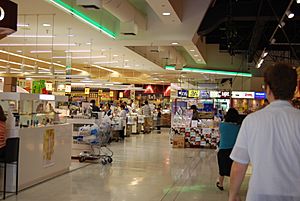
As of 2014, Torrance has the second-largest number of Japanese people in any U.S. city, after Honolulu. Many Japanese car companies and other Japanese businesses have their main offices there. Because of this, Torrance has many Japanese restaurants and cultural spots. One writer even called Torrance "Japan's 48th prefecture". A Mitsuwa supermarket, Japanese schools, and Japanese banks serve the community.
Before World War II, the South Bay area was one of the few places where non-U.S. citizens could buy land. This led to a Japanese presence there. Many Japanese companies, starting with Toyota, moved to Torrance. Toyota moved its offices to Torrance in 1982 because it was close to the Port of Long Beach and Los Angeles International Airport. Many other Japanese companies followed.
As of 1988, Gardena also has a large Japanese American community. Early in Gardena's history, Japanese migrants played a big role in farming.
Some Japanese businesspeople prefer to live in the Palos Verdes Peninsula. They find it more affordable than other fancy areas. They also like the ranch-style houses because they are "more like a Japanese home—single-story, spread out." Other popular places include Pasadena, San Marino, and Arcadia. Some also like Hancock Park in Los Angeles, which is close to the Japanese Consulate.
Who Lives Here: Demographics
A 2010 report showed that 70% of Japanese Americans in Los Angeles County were born in the U.S. This is the highest rate among Asian ethnic groups. The report also found that 19% of Japanese Americans were senior citizens, also the highest rate. From 2000 to 2010, the Japanese American population grew by only 1%, the lowest rate among Asian groups.
In 1986, the head of the Japan Business Association of Southern California said that about 3,500 Japanese citizens worked for 530 Japanese companies in the Los Angeles area.
How the Economy Works
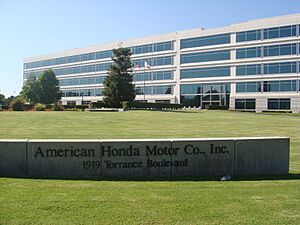
The city of Torrance is home to the main offices of many Japanese carmakers and other Japanese companies. The headquarters for American Honda Motor Company, Honda's North American division, is in Torrance. Toyota Motor Sales, U.S.A., Inc., Toyota's U.S. division, also had its headquarters in Torrance until 2017, when it moved to Texas. All Nippon Airways has its U.S. headquarters in Torrance. Japanese supermarket chains like Mitsuwa Marketplace and Nijiya Market are also based there.
Japan Airlines moved its U.S. headquarters to El Segundo in 2003. Nissan used to have its North American headquarters in Carson but moved to Tennessee in 2006.
In 1987, there were 194 Japanese companies with offices in the area between Los Angeles International Airport and the Port of Los Angeles. By 1989, there were 693 Japanese companies with offices in Southern California. The number of Japanese managers and executives working here reached a high of 3,800 before 1994. By 1994, this number dropped to 3,400 because Japan was facing an economic slowdown.
Learning and Schools
In 1979, there were two schools in Greater Los Angeles for Japanese national students, with a total of 356 students. In the 1980s, as more Japanese businesses came, more students enrolled in these schools. By 1987, there were three school campuses with 4,430 students in Gardena, Hermosa Beach, and Torrance.
Full-time Schools
As of 1989, the Torrance Unified School District and the Palos Verdes Peninsula Unified School District had 42% of all Japanese-speaking students in Los Angeles County. The Palos Verdes district had 346 students born in Japan in 1985, and this number grew to 434 by 1988.
The Nishiyamato Academy of California is in Lomita. It opened in April 1992. It was started by a Japanese politician as a branch of a school in Japan. In 1994, it taught grades 5 through 9 and had 71 students.
There was another full-time Japanese school called the International Bilingual School. It was for children of Japanese workers from companies like Honda and Toyota. It opened in Torrance in 1979, then moved to Hermosa Beach, and later to Palos Verdes Estates in 1992.
Part-time Schools
Asahi Gakuen is a part-time Japanese school in the Los Angeles area. It was founded to promote Japanese language education. In 1988, it had 2,500 students. The school teaches Japanese language, science, social studies, and math. The Japan Traders' Club of Los Angeles helps support the school financially.
The main campus of the East-West Japanese School is in Gardena. It also has branches in Rolling Hills Estates and Costa Mesa. Most of its students are Japanese children who go to American schools. The school offers two-hour classes on weeknights.
The Southern California Conference of Seventh-day Adventists supports the East-West School. In 1987, the principal said students do short Bible studies, even though most are not Christian.
Nishiyamato Academy also has its own Saturday school program.
The Japanese Language School Unified System, started in 1949, had a main campus in Los Angeles and a branch in Sun Valley by 1988. The San Fernando Valley Japanese Language Institute in Arleta began around 1928.
The Rafu Chuo Gakuen is a part-time Japanese language school on Saratoga Street in Boyle Heights. It was founded in 1929. It serves as a cultural and language center for Japanese children of all ages. It is part of a system of schools that focuses on language fluency, cultural understanding, and history.
Fun and Culture
The Japanese American National Museum and the Japanese American Cultural and Community Center (JACCC) are both in Little Tokyo. The community center has an art gallery, a large theater, a plaza designed by Isamu Noguchi, and a Japanese Garden. A memorial stands outside the center to honor Japanese Americans who died serving in the military. The Go For Broke Monument also remembers Japanese Americans who fought in World War II. The Union Center for the Arts is on Judge John Aiso Street. The Nisei Week festival happens every August, supported by Little Tokyo businesses.
Other Japanese American Community Centers were started after the difficult time of the internment of Japanese Americans. Today, many of these places are centers for cultural exchange. You can find them in Venice, Long Beach, Sun Valley, and other areas with many Japanese residents.
Because of the many Japanese businesses, Torrance has many Japanese restaurants and cultural activities. One writer even called Torrance "Japan's 48th prefecture".
The OC Japan Fair takes place in Orange County.
Famous People from the Community
- John F. Aiso (1909–1987), a judge
- Sei Fujii (1882–1954), a civil rights activist
- Brittany Ishibashi (born 1980), actress (from Orange County)
- Lance Ito (born 1950), a judge
- Shoson Nagahara, a writer
- John Naka (1914–2004), a plant expert
- Kyle Nakazawa (born 1988), a soccer player
- Isamu Noguchi (1904–1988), an artist and architect
- Thomas Noguchi (born 1927), a medical examiner
- Yuji Okumoto (born 1959), an actor
- Jolene Purdy (born 1983), actress (half-Japanese) - from Torrance
- James Shigeta (1929–2014), an actor
- T. K. Shindo (1890–1974), a photographer
- Miiko Taka (born 1925), an actress
- George Takei (born 1937), an actor
- Togo Tanaka (1916–2009), a newspaper journalist and editor
- Paul Terasaki (1929–2016), a scientist
- Tamlyn Tomita (born 1966), an actress
- Miyoshi Umeki (1929–2007), an Academy Award-winning actress
- Karen Fukuhara (born 1992), an actress
More to Explore


